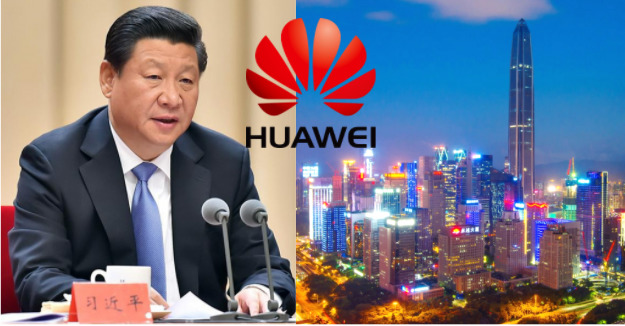The Donald Trump-led crusade against Huawei and other Chinese tech companies is killing the Chinese economy. In fact, it may have already drawn first blood in the form of Shenzhen- China’s own Silicon Valley located in the Communist country’s Southeastern province of Guangdong.
SCMP has reported, “US sanctions on China’s Huawei spell trouble for Shenzhen economy”. The report suggests that the demise of Huawei’s global ambitions would cut Shenzhen to size. And after all, Huawei is not the only company facing setbacks across the world, rather all major Chinese tech companies are facing some kind of issue that could collectively bring down China’s tech and innovation hub, Shenzhen.
Ironically, Shenzhen is staring at a major setback ahead of its 40th anniversary as one of China’s first four Special Economic Zones (SEZs). Historically a fishing village, Shenzhen, had failed to make a mark even after it was established as an SEZ under the then Chinese President Deng Xiaoping’s ‘Reform and Opening-up’.
However, Shenzhen’s fortunes changed in 1987 after Rem Zhengfei, a Chinese People’s Liberation Army (PLA) veteran established Huawei here. The Southeastern Chinese city grew at a breakneck speed that came to be known as ‘Shenzhen speed’. Almost three decades hence, Huawei emerged as China’s biggest private company and Shenzhen’s prized jewel. Huawei also became China’s only global telecom company with staggering annual revenue of 123 billion US Dollars.
Today, the biggest of Chinese tech giants, including the genome sequencing company, BGI, China’s premier electric IT and automobiles company, BYD gaming and communications tech giant, Tencent, China’s largest listed telecom company, ZTE and the global telecom firm Huawei, are based out of Shenzhen.
However, Huawei leads the pack. It is to Shenzhen what Apple Inc. is to the Silicon Valley of the United States of America. In fact, Huawei’s dominance in Shenzhen exceeds Apple’s dominance in the Silicon Valley.
Huawei is the single largest contributor to Shenzhen’s GDP. As of 2016, the global 5G tech giant accounted for about 7 per cent of the city’s economic output. Huawei overshadows other tech giants like Tencent and BYD which are also headquartered in Shenzhen.
Not just the Shenzhen tech economy, Huawei has also helped the Southeast Chinese city emerge as the centre of China’s programming and engineering talent. The telecom company has a reputation for rewarding both bright minds and hardworking individuals in the tech sector.
But the ‘Shenzhen speed’ fuelled by Huawei is bound to face some severe roadblocks ahead, as Huawei, which fuelled Shenzhen’s staggering growth, itself runs into trouble. For the past two years or so, the Trump administration has been trying hard to get Huawei eliminated from the biggest smartphone markets in the world over security concerns. Consequently, Washington has managed to rule Huawei out of the 5G race in countries like Australia, India and the United Kingdom. Huawei’s future also looks bleak in countries like France, Germany and Brazil.
Moreover, US President Donald Trump’s recent decision to effectively prohibit Huawei and its affiliates from buying semiconductors has made even the Chinese telecom giant’s survival difficult.
Beijing itself is panicked with the thought of the damage that Huawei’s downfall would inflict on Shenzhen. Liu Kaiming, director of the Institute of Contemporary Observation in Shenzhen, said, “There is no other company in China that can replace Huawei to lead the country’s tech and globalisation.” Kaiming wondered, “If Huawei can’t withstand US sanctions, who can?”
And then Shenzhen’s troubles are hardly limited to the American onslaught against Huawei. Other Chinese tech giants aren’t facing any despite either, like Tencent, which owns the popular Chinese social media app WeChat. Recently, Trump signed an executive order that bars American companies from transacting on WeChat. Trump is looking to ban WeChat much likeTikTok. This comes as a body-blow for Tencent, China’s second-largest tech company.
Moreover, ZTE itself being a telecom equipment giant is facing the same issues as Huawei, that is, security concerns within the US and Trump’s bid to decouple from China. Similarly, BYD- an undisputed leader in IT, automobiles and new energy technology as countries like Japan, the US, Australia and India are also trying to topple China in the new energy market.
And to top it all, the US is cracking down on Chinese spies who are instrumental in stealing American Intellectual Property (IP). Countries across the world have also come to realise that China is robbing them of their intellectual wealth through its Thousand Talents Plan. Therefore, Shenzhen will no longer be able to illegally tap into research and innovation happening in other parts of the world.
For the past few decades, Shenzhen has remained the epitome of Chinese economic growth. Last year, Shenzhen’s economy surpassed even Hong Kong’s. But as the Chinese tech ambitions crash, Shenzhen could be the first casualty in what is likely to be a long-term process of the Chinese economy’s dramatic demise.
